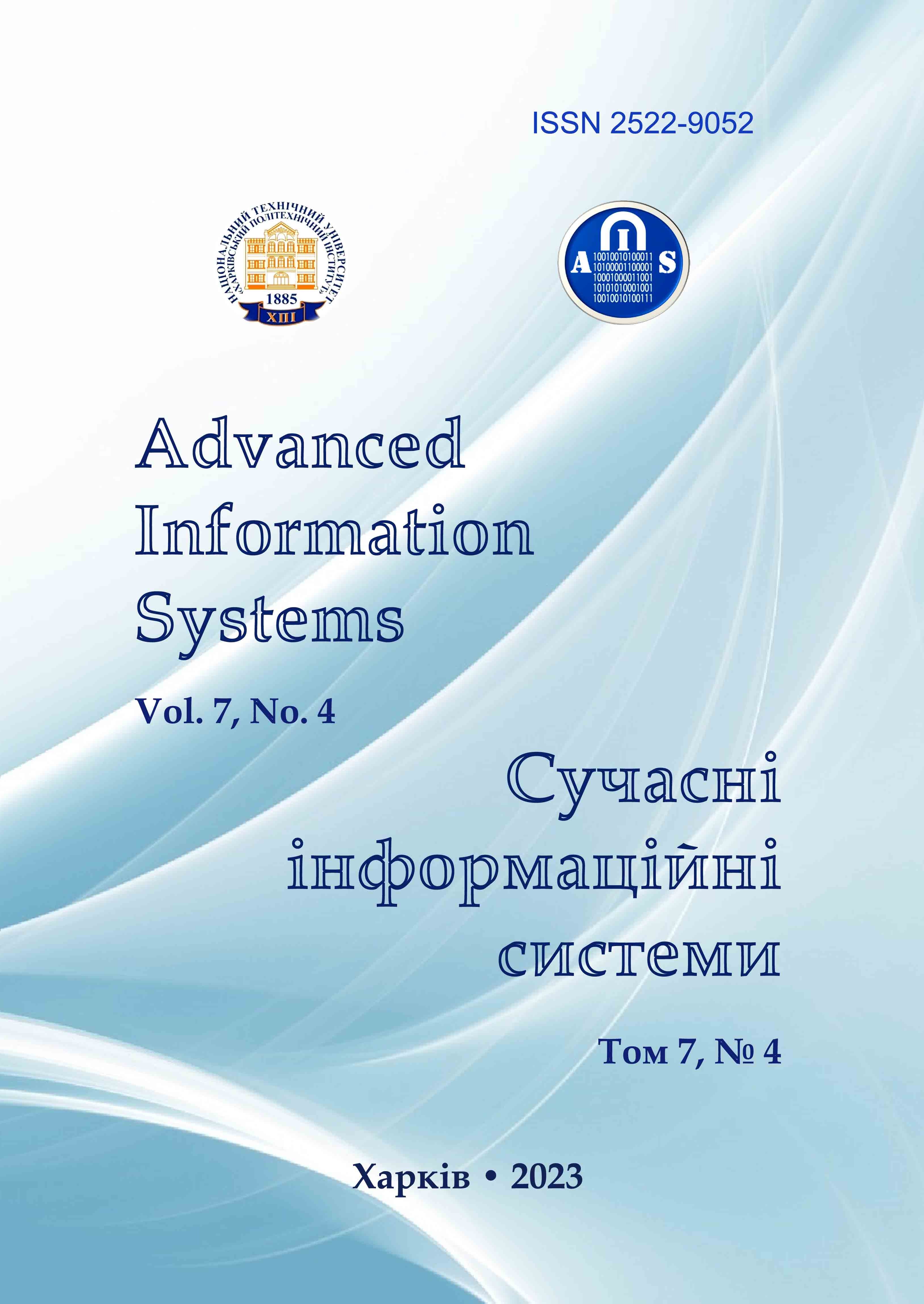Calculation of the results of basic arithmetic operations with quaternions defined in the interval form
Main Article Content
Abstract
The goal of the work. Creation of an EXCEL-oriented calculator for determining the results of basic arithmetic operations with quaternions, which are given by hyperbolic interval numbers. The subject of research is the set of quaternions and arithmetic operations defined on this set. Research method: Algorithmic and numerical analysis of procedures for performing basic arithmetic operations with quaternions given by hyperbolic interval numbers. The obtained results. The definition of a quaternion, the coefficients of which are interval numbers, is given. It was obtained the ratios for determining in the interval form the following characteristics: quaternion norm, quaternion modulus, quaternion vector part modulus, quaternion argument, quaternion sign was obtained. It was obtained the ratios for determining in the interval form the following basic arithmetic operations: sum of quaternions, difference of quaternions, multiplication of a constant value by a quaternion, scalar product of quaternions, product of vector parts of quaternions, product of quaternions, vector product of quaternions, left and right division of quaternions. The ratio for calculating the determinants of the second order, the elements of which are defined in the interval form, is obtained. The ratio for the approximate calculation of determinants of arbitrary order, the elements of which are defined in the interval form, is obtained. It is shown that the operations of multiplication (division) of interval numbers and raising them to an integer power are expedient to perform when they have a hyperbolic form. It is advisable to perform the addition (subtraction) operation with interval numbers given in the classic form or in the CENTER-RADIUS system. It is better to use the last form in the case of determining the coefficients of the quaternions based on the results of technological calculations. Screenshots of the formulas for determining the vector product of quaternions are given, provided that the coefficients at their orths are represented by interval numbers.
Article Details
References
Horodetskyi, V.V. and Bodnaruk, S.B. (2021), Introduction to the theory of hypercomplex numbers and their func-tions: teaching, Chernivtsi National University, Chernivtsi, 136 p., available at: https://archer.chnu.edu.ua/jspui/handle/123456789/1521
Dubovyk, V.P. and Yuryk, I.I. (2006), Higher mathematics, A.S.K, Kyiv, 648 p., available at:
https://pdf.lib.vntu.edu.ua/books/Dubovik_P1_2008_200.pdf
Arnold, V. (2002), Geometry of complex numbers, quaternions and spins, MCNMO, 40 p., available at:
https://old.mccme.ru//free-books//izdano/2002/VIA-kvatern.pdf
Gordeev, V.N. (2016), Quaternions and biquaternions with applications in geometry and mechanics, Stal, Kyiv, 316 p., available at: https://www.researchgate.net/publication/326377622
Kantor, I.L. and Solodovnikov, A.S. (1973), Hypercomplex numbers, Nauka, 144 p. available at:
https://retrokniga.com/allproduct/books/kantor-il-solodovnikov-as-giperkompleksnyie-chisla
Ilienko, M. and Runovska, L. (2015) “Quaternions as mathematical tools in computer graphics: methodological as-pects”, Technical sciences and technologies, No. 2 (2), pp. 124-128, available at: http://ir.stu.cn.ua/123456789/9973
John H., Conway (2003), On quaternions and octonions: Their geometry, arithmetic, and symmetry, A. K. Peters, Ltd, London, 159 p. available at: https://math.ucr.edu/home/baez/octonions/conway_smith/conway_smith.pdf
Synkov, M. V., Kalinovskyi, Ya. O., Postnikova, T. G., Synkova, T. V. and Boyarinova, Yu. E. (2005), “Algorithmic and software toolkit for analytical calculations on hypercomplex numbers in the computer mathematics system MA-PLE”, Data Recording, Storage & Processing 2005., Vol. 7, No. 2, pp. 18-25, available at:
http://dspace.nbuv.gov.ua/handle/123456789/50763
Kalinovsky, Ya. A., Boyarinova, Yu. E., Sukalo, A. S. and Khitsko, Ya. V. (2017), “System of hypercomplex opera-tions in Maple”, Data Recording, Storage & Processing, Vol. 19, No. 2, pp. 11-22, available at:
http://dspace.nbuv.gov.ua/handle/123456789/131674
Gadetska, S., Dubnitskiy, V., Kushneruk, Yu. and Khodyrev, A. (2022), “Performance of basic arithmetic actions with complex numb”, Vol. 6, No. 3, pp. 104–113, doi: https://doi.org/10.20998/2522-9052.2022.3.11
Yaglom, I.M. (1963), Complex numbers and their application in geometry, NAUKA, 192 p., available at:
https://math.ru/lib/book/djvu/yaglom/compl_num.djvu
Pan, L., Deng, Y. and Cheong, K.H. (2023), “Quaternion model of Pythagorean fuzzy sets and its distance measure”, Expert Systems with Applications, Vol. 213, Part 1, 119222, doi: https://doi.org/10.1016/j.eswa.2022.119222
Pobegailo, A.P. (2019), Application of quaternions in computer geometry and graphics, BGU, Minsk, 222 p., availa-ble at: https://elib.bsu.by/bitstream/123456789/241677/1/Pobegailo.pdf
Zhukovska, O.A. (2009), Basics of interval analysis, Osvita Ukrajiny, Kyiv, 136 p., available at:
https://z-lib.io/book/16508268
Hadetska, S.V., Dubnytskyi, V.Yu., Kushneruk, Yu.I, and Khodyriev, O.I. (2022), “Performing basic arithmetic opera-tions with complex numbers, which are presented in interval hyperbolic form”, Advanced Information Systems, Vol. 6, No. 1, pp. 104–113, doi: https://doi.org/10.20998/2522-9052.2022.1.17.
Bezushchak О.О (2019), Study guide on linear algebra for mechanical engineering students, VOC "Kyiv Universi-ty", Kyiv, 224 p., available at: https://www.mechmat.univ.kiev.ua/wp-content/uploads/2019/11/linear-algebra.pdf
Richard J., Duffin, Elmor L., Peterson and Clarence, Zener (1967), Geometric Programming, John Wiley and Sons, New York, 278 p., available at: https://lib.ugent.be/catalog/rug01:000485203
Hoff, A. (2004), “The Linear Approximation of the CES Function with n Input Variables”, Marine Resource Econom-ics, Vol. 19, No. 3, pp. 295–306, available at: https://www.jstor.org/stable/42629436
Dubnitskiy, V., Kobylin, A., Kobylin, O., Kushneruk, Yu. and Khodyrev, A. (2023), “Calculation of harrington func-tion (desirability function) values under interval determination of its arguments”, Advanced Information Systems, Vol. 7, No. 1, pp. 71–81, doi: https://doi.org/10.20998/2522-9052.2023.1.12
